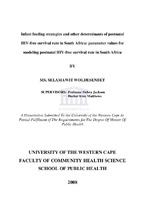| dc.description.abstract | Background: Mother to child HIV transmission is a significant public health problem especially in Southern Africa. South Africa is the second highest burden country globally with 71 000 infants being HIV infected every year. The aim of this study was to identify and measure the influence of risk factors of late postnatal HIV transmission and/or mortality among infants born to HIV positive mothers. Study design: Historical cohort data collected during 2002 – 2004 from 3 purposively selected PMTCT sites in South Africa (namely: Rietvlei, Umlzai and Paarl) is used. These three sites are purposively selected to reflect different HIV prevalence, socioeconomic and geographical locations. A total sample size of 469 mother–infant pairs were followed for 36 weeks. Data Collection: Data were collected by trained field researchers and community health workers using semi-structured interviews including: infant feeding practices, infant and maternal mortality, disclosure of HIV status, basic knowledge of HIV/AIDS and MTCT and sociodemographic information. Dried blood spots were collected by heel prick in the baby at 3, 24 and 36 weeks, whilst in the mother finger prick was taken at 3 and 36 week
visits. Data Analysis: Data from all questionnaires were coded, captured and cleaned. STATA version 10 is used to analyze and measure the independent influence of risk factors of HIV-free survival rate. Variables found having significant association in the bivariate analysis were analyzed using Cox-proportional hazard model. Result: Our study shows that early mixed feeding is a common practice in South Africa. Overall, 83% (as high as 90.26% in Rietvlei) of mothers were either mixed breast feeding
or mixed formula feeding before the infant is at age 5 weeks. MBF at 7 weeks was associated with 3.5 fold increased risk of transmission and/or mortality as compared to EBF (p-value=0.22), while PBF had a 2 fold less hazard of transmission and mortality compared to MBF (p-value=0.1). In this study, failure to disclose, poor counselling and lack of close support by health facilities were major factors that contributed to inappropriate feeding choice and non-compliance to exclusive feeding. Poor counseling (below the average of expected level) had an associated 55% increased risk of transmission and/or mortality. A substantial proportion (70.61%) of women in our study didn’t disclose their status to anyone. Failure to disclose was associated with 44% of increased risk of transmission and mortality. The study also showed households who had shortage of food were at increased risk (adjusted hazard ratio 1.7) of HIV transmission and/or mortality of infants. Maternal and infant factors such as premature birth, maternal viral load, poor weight gain during pregnancy and low birth weight were significant influential factors of HIV-free survival rate. Conclusion: In general, this study has given us an idea that postnatal HIV-free survival is determined by the interrelated effect of multilevel co-factors. Therefore, comprehensive multi-sectorial approach is needed to address the MTCT and child mortality problem in South Africa. The health sector should take urgent action to improve the quality of counselling and health services given in health facilities. Government should give enough
attention to reduce the bureaucratic hassles of receiving grant by HIV positive mothers. | en_US |

